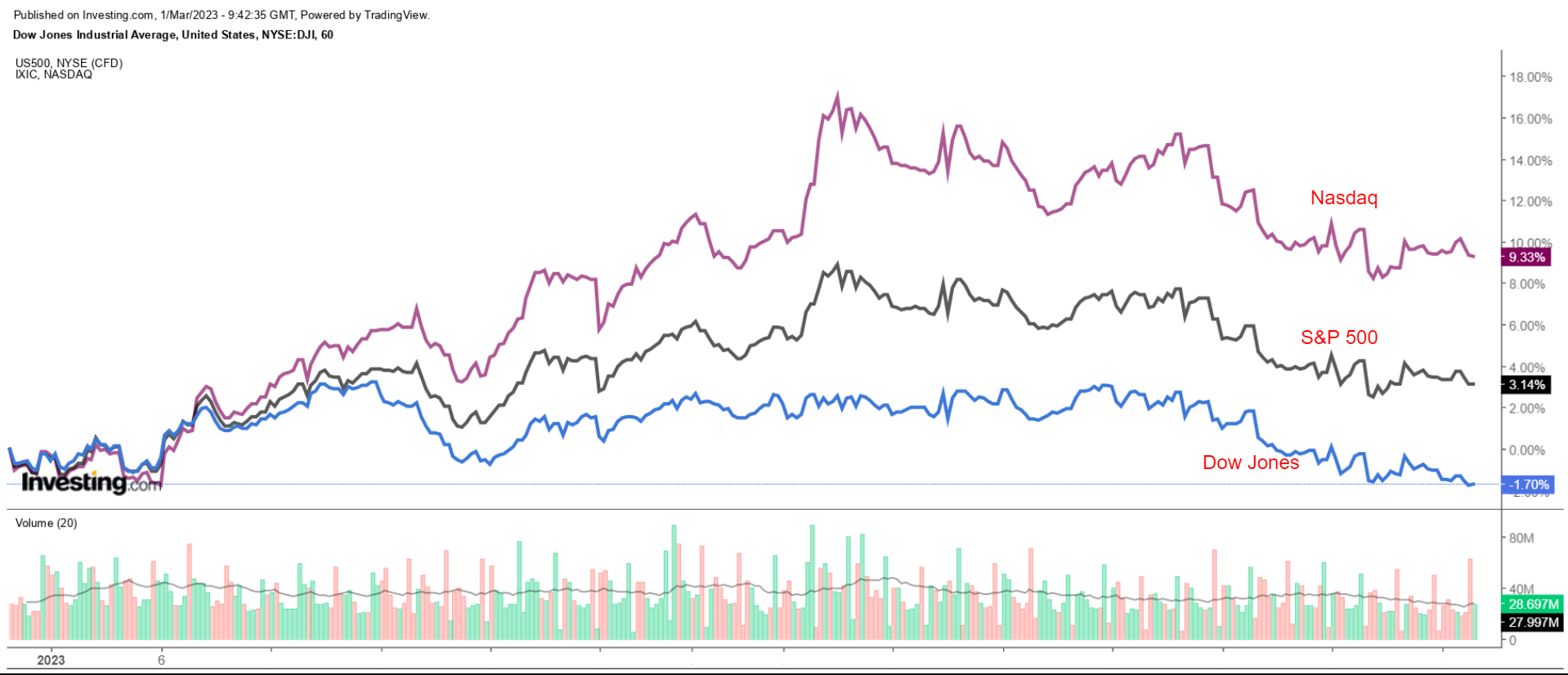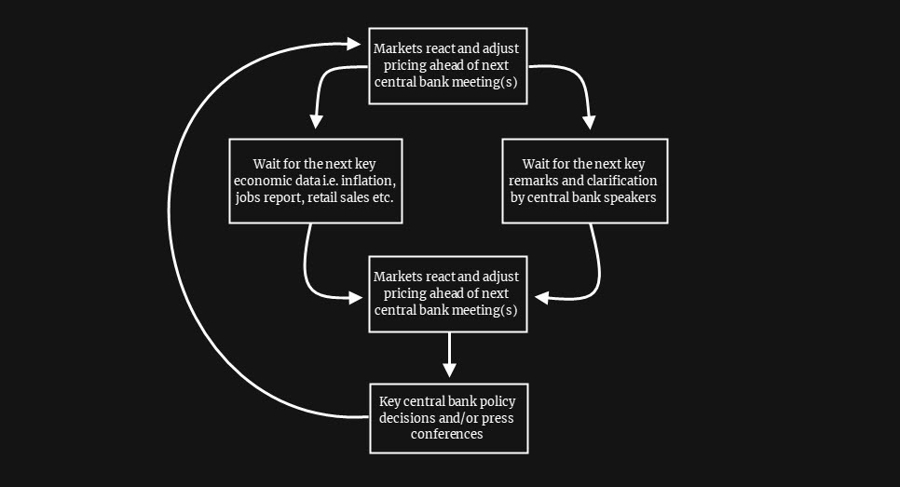Oklo stock tumbles as Financial Times scrutinizes valuation
- March is expected to be one of the most important months on Wall Street in recent years
- Market focus will be on the nonfarm payrolls report, inflation data, and the Fed’s highly anticipated policy meeting
- As such, investors should brace for more violent swings and sharp moves in the coming weeks
Stocks on Wall Street ended February on a decidedly wobbly note, casting doubt about the durability of an early 2023 rally.
After a strong start to the year in January, the Dow Jones Industrial Average fell by 4.2% in February to leave the blue-chip index down 1.5% on the year.
Meanwhile, the benchmark S&P 500 index lost 2.6% last month to trim its year-to-date gain to 3.4% and the tech-heavy Nasdaq Composite dropped 1.1%, reducing its 2023 gain to 8.9%.
Cracks began to emerge in an early-year rally as investors were forced to rethink their expectations around how high the Federal Reserve would lift interest rates amid signs pointing to a resilient economy and still-high inflation.
As such, the month ahead is expected to be one of the most important on Wall Street in recent years amid a plethora of market-moving events, which could potentially dictate the direction of the market through the end of 2023.
5 Key Dates to Circle on the Calendar
March will likely be a repeat of the last few months in terms of what markets will be looking at to dictate price action, including the monthly jobs report, the latest inflation figures and retail sales numbers, as well as the upcoming Fed FOMC policy meeting.
Source: ForexLive
1. Friday, March 10: U.S. Jobs Report
The U.S. Labor Department will release the highly anticipated February nonfarm payrolls report on Friday, March 10, at 08:30 ET. Forecasts center around a continued solid pace of hiring, even if the increase is smaller than in previous months.
The consensus estimate is that the data will show the U.S. economy added 200,000 positions, according to Investing.com, slowing from jobs growth of 517,000 in January. The unemployment rate is seen edging up to 3.5%, one tick above January’s 53-year low of 3.4%, a level not seen since 1969.
To put things in context, the unemployment rate stood at 3.8% exactly one year ago in February 2022, a sign that more Fed rate hikes will be needed to rein in the red-hot labor market.
Fed officials have signaled that the unemployment rate needs to be at least 4.0% to slow inflation, while some economists say the jobless rate would need to be even higher. Either way, low unemployment - combined with healthy job gains - points to more rate hikes to come in the months ahead.
- Prediction: I believe the February jobs report will underscore the remarkable resilience of the labor market and support the view that the Fed’s ongoing efforts to cool the economy are not yet having the desired impact.
2. Tuesday, March 14: U.S. CPI Data
The February consumer price index (CPI) report looms large on Tuesday, March 14, and analysts expect it could be hotter than January’s 6.4% year-over-year pace, suggesting that the Fed will maintain its fight against inflation.
While no official forecasts have been set yet, expectations for annual CPI range from an increase of 6.1% to 6.5%. Consumer prices peaked at 9.1% in June and have been on a steady downtrend since, however, inflation is still well above what the Fed would consider consistent with its 2% target range.
Meanwhile, estimates for the year-on-year core figure center around 5.5-5.7%, compared to January’s 5.6% reading. The underlying number is closely eyed by many economic observers, including Fed officials, who believe that it provides a more accurate assessment of the future direction of inflation.
- Prediction: Overall, while the trend is lower, the data will likely reveal that neither CPI nor core CPI are falling fast enough for the Fed to slow its inflation-fighting efforts this year.
3. Wednesday, March 15: U.S. PPI, Retail Sales
With the Fed being data-dependent, the market will pay close attention to the February producer price index report as well as the latest retail sales figures, which are both due at 07:30 ET on Wednesday, March 15.
The data will take on extra importance this month, as it will be the final piece of information the Fed receives before making its policy decision.
Stocks sold off sharply on the days of the PPI and retail sales reports last month after the data showed a higher-than-expected increase in wholesale prices, while retail sales scored their biggest monthly gain in almost two years.
- Prediction: I anticipate the pair of reports will add to mounting evidence that the U.S. economy is in no serious danger of a recession just yet, which in turn will keep up pressure on the Fed to crack down harder on growth to curb prices.
4. Wednesday, March 22: Fed Rate Hike, Powell Speech
The Federal Reserve is almost certain to raise interest rates by a quarter point at the conclusion of its two-day policy meeting at 14:00 ET on Wednesday, March 22. That would put the fed funds target range in a range between 4.75% and 5.00%.
With that being, traders have started to price in the possibility of a larger 50-basis-point rate hike, although the odds remain low at about 25%, according to the Investing.com Fed Rate Monitor Tool.
But that, of course, could change in the days leading up to the big rate decision, depending on the incoming data.
Fed Chairman Jerome Powell will hold what will be a closely watched press conference shortly after the release of the Fed's statement, as investors look for fresh clues on how he views inflation trends and the economy and how that will impact the pace of monetary policy tightening.
The U.S. central bank will also release new forecasts for interest rates and economic growth, known as the "dot-plot," which will reveal greater signs of the Fed's likely rate hike trajectory through 2023 and beyond.
Fed rate hike bets have surged in the past couple of weeks - with the peak rate now seen in the range of 5.25-5.50% by June - after a batch of upbeat data fueled expectations the Fed could continue raising borrowing costs through summer and keep them higher for longer.
- Prediction: As the economy holds up better than expected and inflation remains stubbornly high, I expect the U.S. central bank will strike a hawkish tone at its March policy meeting. In addition, I believe Powell will warn that there is still more work for the Fed to do to slow the economy and cool inflation, resulting in higher interest rates in the months ahead.
As such, it is my belief that the Fed will be forced to lift the policy rate above 5.50% at some point this year, perhaps taking it even as high as 6.00%, before entertaining any idea of a pause or pivot in its battle to restore price stability.
5. Friday, March 31: U.S. PCE Inflation Report
The final economic indicator for the month will arrive on Friday, March 31, when the U.S. government releases the personal consumption expenditures (PCE) price index, which is the Fed’s preferred gauge of inflation.
Wall St. was rattled last month after the January PCE report showed that the index shot up 5.4% on a year-on-year basis, after rising 5.3% in the preceding month.
Excluding the volatile food and energy components, the core PCE price index increased 4.7% in the last 12 months, picking up from a 4.6% annual pace in December.
- Prediction: Similar to my expected outcomes for the CPI and PPI reports, I believe the PCE price data will highlight how little progress the Fed is making in its fight against inflation.
Bottom Line
Between fears over the path of higher-for-longer interest rates and accelerating inflation, I reckon that U.S. stocks will remain under pressure in March.
Furthermore, until we see signs that inflation is convincingly falling to acceptable levels and the Fed has undoubtedly pivoted, a new sustained bull market in risk assets is unlikely in opinion.
As the old Wall Street market adage says, don’t fight the Fed.
- Prediction: Investors should be prepared for a scenario in the coming weeks that could see the S&P 500 retest its mid-November low near the 3,750 level - a decline of almost 6% from where it currently stands - before a more forceful plunge takes the index back to its bear market low of about 3,500 during the lead-up to the Q1 corporate earnings season in April.
***
Disclosure: At the time of writing, I am short on the S&P 500 and Nasdaq 100 via the ProShares Short S&P 500 ETF (SH) and ProShares Short QQQ ETF (PSQ). I regularly rebalance my portfolio of individual stocks and ETFs based on ongoing risk assessment of both the macroeconomic environment and companies' financials. The views discussed in this article are solely the opinion of the author and should not be taken as investment advice.
